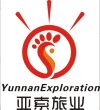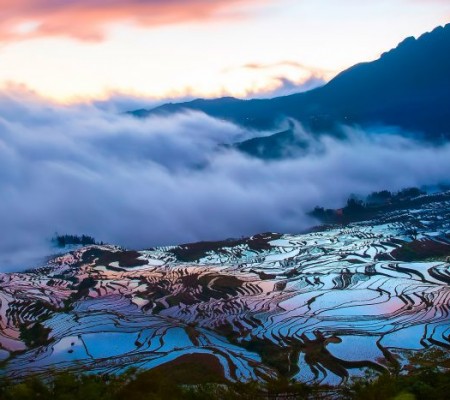
Yuanjiang National Nature Reserve, Yuxi
Overview
Yunnan Yuanjiang National Nature Reserve is located in the south-central part of Yunnan Province (云南省), within Yuanjiang County (元江县), Yuxi City (玉溪市). The geographical coordinates range from 101°21′24″ to 102°21′12″ East longitude and from 23°19′12″ to 23°46′12″ North latitude. The reserve consists of two separate zones: the East Bank Area of Yuanjiang (江东片区) and the Zhangbawang Xiangtai Area (章巴片区). In 2012, it was upgraded to a national-level nature reserve with the approval of the State Council.
Yunnan Yuanjiang National Nature Reserve covers a total area of 22,378.9 hectares. It primarily aims to protect the most typical dry-hot valley savanna vegetation in China, relatively intact montane evergreen broadleaf forests, and a rich diversity of rare and endangered wildlife species. The reserve is categorized as a forest ecosystem nature reserve.
Historical Development
In 2012, with the approval of the State Council of China, the reserve was officially upgraded to a National Nature Reserve.
Geographical Environment
Location
The reserve is located in the south-central region of Yunnan Province (云南省), within the jurisdiction of Yuanjiang County (元江县), Yuxi City (玉溪市). The geographic coordinates are 101°21′24″–102°21′12″ E and 23°19′12″–23°46′12″ N.
Geology
In terms of tectonic division, the reserve lies in the junction of two major primary tectonic units. The Honghe Deep Fault (红河深断裂) serves as a rough boundary:
- To the west is the central part of the Lanping–Simao Fold System (兰坪—思茅褶皱系).
- To the east lies part of the Yangtze paraplatform (扬子准地台).
Since the Miocene epoch of the Tertiary period, the Himalayan orogeny has had a profound influence on the region. The uplift of the Ailao Mountains (哀牢山) and the Central Yunnan Plateau (滇中高原), combined with the deep incision of the Yuanjiang River (元江), has led to a striking terrain characterized by steep elevation differences between mountains and valleys.
Since the Quaternary period, neotectonic movements have continued to deepen the Yuanjiang River, with uneven uplift of mountains on both sides, greatly shaping the region’s current geomorphology.

Topography
The topographical features of the Yunnan Yuanjiang National Nature Reserve are significantly influenced by two major fault zones. The reserve’s various sections are located in wide fault-trough valleys of the Yuanjiang River and also exhibit characteristics of both the Ailao Mountains and the marginal highlands of the Central Yunnan Plateau. The landscape is predominantly mountainous, belonging to the tectonic-eroded mountains on the eastern slope of the Ailao Mountains and the western side of the Central Yunnan Plateau. The average elevation ranges from 1,800 to 2,000 meters, with the highest peak being Abo Lie Peak (阿波列峰) in the Yuanzhangba area, reaching 2,580 meters above sea level.
There are no large basins within Yuanjiang County; the reserve contains only fault-trough erosion valleys, forming narrow basins aligned with the course of the Yuanjiang River, flanked by terraced landforms on either side. Except for a few rivers with wide valleys, most rivers have steep V-shaped gorges, among which the Xiaohedi River and Qingshui River gorges are the most representative.
Notably, the Yuanjiang wide valley lies at a low elevation compared to the surrounding mountains (the lowest point is the confluence of the Yuanjiang and Xiaohedi rivers, at 328 meters above sea level). This low-lying setting contributes to the formation of the dry-hot valley climate, which directly influences the area’s unique and complex vegetation types.
Climate
General Climate Conditions
The Yunnan Yuanjiang National Nature Reserve is situated in a rain shadow zone, shielded from the southeastern and southwestern warm and moist air currents. As these air masses descend over the mountain ridges, they generate a foehn effect, contributing to Yuanjiang’s distinctive climate.
Based on long-term records from the Yuanjiang Meteorological Station (elevation 396.4 meters), the climatic features are as follows:
Temperature: Long Summers and No Winters
- The average annual temperature in the Yuanjiang valley is 23.7°C.
- The hottest month averages 28.6°C, while the coldest month averages 16.7°C.
- The accumulated temperature above 10°C is 8,708.9°C.
- The extreme maximum recorded temperature is 42.3°C.
Due to the mid-mountain canyon terrain, vertical temperature variation is pronounced. With an average temperature drop of about 6°C per 100 meters of elevation, the reserve exhibits distinct climate zones by altitude:
Below 1,000 meters (valley regions):
- Annual average temperature: above 20°C
- Hottest month: 22–25°C, Coldest month: above 10°C
- Zone of typical dry-hot valley vegetation and remnant tropical forests.
800–2,100 meters (mountain slopes):
- Annual average temperature: around 15°C
- Hottest month: below 20°C, Coldest month: above 8°C
- Zone of monsoon evergreen and semi-humid evergreen broadleaf forests.
Above 2,200 meters:
- Characterized by a cool-temperate climate
- Zone of mid-mountain moist evergreen broadleaf forests.
Humidity: Distinct Wet and Dry Seasons
The reserve is located in one of Yunnan’s low rainfall areas, with an average annual precipitation of around 800 mm, while annual evaporation reaches 2,750 mm. The average relative humidity is 68%.
According to long-term meteorological data:
- Rainy season (May–October): 649.0 mm (81% of annual rainfall)
- Dry season (November–April): 152.2 mm (19% of annual rainfall)
Sunshine: Peak in Spring
The reserve area receives 2,200 to 2,400 hours of sunshine annually, with an average of 2,261.7 hours.
Monthly sunshine variation shows:
- January to May: over 200 hours per month
- June to December: less than 200 hours per month
- March has the highest monthly sunshine at 250 hours, while June has the lowest at 162.4 hours.
Consistent with sunshine hours, solar radiation also peaks in spring, accounting for over 30% of the annual total radiation, which ranges from 5,000 to 5,500 megajoules per square meter.

Hydrology
Rivers
The Yuanjiang River Valley has a hot and dry climate, while surface water is relatively abundant in the mountainous areas. The reserve belongs to the Honghe (Yuanjiang) River system, composed of the main stream of the Yuanjiang River and numerous tributaries originating from the surrounding mountains.
The Yuanjiang River originates in Weishan County, Dali Prefecture. Upstream of Yuanjiang County, it is divided into sections known as Lizhuang River, Shiyang River, Jiasa River, and Mosha River. Downstream from the Yuanjiang section, it is referred to as the Honghe (Red River), which flows south through Hekou County and enters Vietnam, eventually emptying into the Gulf of Tonkin at Haiphong. Within Yuanjiang County, the river flows for 79.52 km, with a basin area of 2,299 km². During the flood season, its flow rate can reach 4,300 m³/s, while in the dry season it can drop to 4.1 m³/s. The average flow rate is 177 m³/s, indicating significant variation between wet and dry periods.
Primary tributaries of the Yuanjiang River within or near the reserve include:
- Qingshui River: Originates near Zhangba Old Forest in the county; average annual flow is 7 m³/s, reaching up to 390 m³/s during flood season.
- Nanxi River: Originates from Laoxi Old Forest in the county.
- Xiaohe Di River: Originates in Eshan County and is known upstream as Qingxiang River and Huannian River. It flows through Yuanjiang and joins the Yuanjiang River at the border of Yuanjiang, Shiping, and Honghe counties. It is one of the major tributaries, with peak flood flows reaching 1,400 m³/s.
Groundwater
Although the Yuanjiang valley is hot and dry, the upper mountain areas receive abundant rainfall. With relatively good vegetation coverage, these areas help in water conservation. The mountains consist mainly of metamorphic and sedimentary rocks, which are conducive to water storage and spring emergence. Many fissure springs are found in the area.
Soil
Soil Types
According to the Chinese soil classification system, the natural soils within the nature reserve fall into 4 soil orders, 5 soil groups, and 5 subgroups:
- Ferrallitic soils: Including red soils and lateritic red soils.
- Podzolic soils: Including yellow-brown soils.
- Semipodzolic soils: Including dry red soils.
- Entisols (initial soils): Including calcareous soils.
Vegetation
- Tropical Rainforest
The reserve’s tropical rainforest includes one subtype of montane rainforest with two forest communities: Lithocarpus xylocarpus forest and Terminalia myriocarpa forest. Two forest types: Lithocarpus xylocarpus forest and Terminalia myriocarpa–Vaccinium mandarinorum forest.
The montane rainforest in the Yuanjiang Nature Reserve occurs at altitudes around 1600–1700 meters, notably higher than the usual range for montane rainforests in Yunnan. The communities here contain many elements of monsoon evergreen broadleaf forest and some secondary species. - Monsoon Forest
Includes one subtype: semi-evergreen monsoon forest, with 4 community types and 7 vegetation associations. Distributed between 600–1000 meters in areas such as Mandan and Xila River. - Evergreen Broadleaf Forest
Includes 3 subtypes, 14 community types, and 16 forest associations.
In the hot and dry river valley areas, dry-hot valley vegetation is prevalent. Above 1000 meters, the climate becomes more humid, supporting various evergreen broadleaf forests. Monsoon evergreen broadleaf forests mainly occur in Zhangbawang Xiangtai area, around 2000 meters elevation. - Sclerophyllous Evergreen Broadleaf Forest
One subtype of dry-hot valley sclerophyllous evergreen oak forest, with 2 forest communities.
The reserve marks the southernmost distribution of sclerophyllous forest in China and the lowest elevation at which this forest type occurs. These forests are mainly found in river valleys and their tributaries in areas such as Xila River, Pupiao, and Mandan, at 700–1000 meters elevation. - Deciduous Broadleaf Forest
Includes two forest communities: Cork Oak forest and Tapiscia sinensis forest.
Cork Oak communities are mainly found near Qingshui River at around 1200 meters, areas once used for grazing and firewood collection. Since being included in the reserve, these areas have seen significant vegetation recovery.
Tapiscia sinensis is rare in the reserve, found sporadically in the Zhangba area above 2100 meters and does not form large stands. - Warm-Temperate Coniferous Forest
Includes two subtypes: warm-hot and warm-temperate coniferous forests, with three communities: Pinus kesiya (Simao pine), Pinus yunnanensis (Yunnan pine), and Keteleeria evelyniana (Yunnan catkin spruce).
Simao pine is found near Xila River between 1053–1100 meters; Yunnan pine occurs above 1900 meters in some areas; Yunnan catkin spruce grows at elevations of 1300–1400 meters in localized regions. - Sparse Tree Shrub-Grassland
One subtype: dry-hot sparse tree shrub-grassland, with 4 community types.
Found in Pupiao, Mandan, Shidi New Village, and Sixth Brigade Farm areas. Typically forms fragmented patches, dominated by herbaceous plants, with ground cover often exceeding 80%. The dominant grass is Imperata cylindrica (yellow blady grass). Shrubs are sparse or scattered among the grass. Occurs between 350–890 meters elevation. These areas turn yellow in the dry season and green again during the rainy season. - Shrubland Vegetation
One subtype: dry-hot valley shrubland, with two communities: Euphorbia antiquorum (prickly tree cactus) and Senna surattensis (yellow-flowered cassia). 
Scope of the Area
As of 2012, the Yuanjiang National Nature Reserve in Yunnan (云南元江国家级自然保护区) consists of two sections: the Yuanjiang East Bank Area (江东片区) and the Zhangbawangxiangtai Area (章巴片区), with a total area of 22,378.9 hectares.
Conservation Objectives
Conservation Targets
The main conservation targets of Yuanjiang National Nature Reserve (云南元江国家级自然保护区) are the most typical valley-type savanna vegetation found in China’s dry-hot river valleys, relatively intact mountain evergreen broad-leaved forests, and abundant rare and endangered wild animal and plant resources.
Plant Resources
Yuanjiang National Nature Reserve (云南元江国家级自然保护区) is home to 2,303 species of vascular plants, belonging to 206 families and 931 genera. Among them, there are:
- 223 species of ferns, in 40 families and 96 genera
- 8 species of gymnosperms, in 3 families and 4 genera
- 2,072 species of angiosperms, in 163 families and 831 genera
The fern flora is of tropical and subtropical nature. In terms of genera, pantropical and East Asian distributions dominate, accounting for 34.6% and 28.3% respectively. In terms of species, East Asian and tropical Asian distributions dominate, accounting for 45.6% and 31.1% respectively.
The seed plant flora shows a strong tropical nature, with 67.7% of the genera and 65.5% of the species having tropical distribution characteristics. Although temperate elements increase with elevation, tropical components remain prominent throughout the reserve.
Animal Resources
Mammals
A total of 97 mammal species have been recorded in the reserve. Among them:
National First-Class Protected Species include:
- Phayre’s leaf monkey (灰叶猴)
- Slow loris (蜂猴)
- Pygmy slow loris (倭蜂猴)
- Stump-tailed macaque (熊猴)
- Leopard (金钱豹)
- Clouded leopard (云豹)
- Forest musk deer (林麝)
- Chinese pangolin (中国穿山甲)
National Second-Class Protected Species include:
- Asiatic black bear (黑熊)
- Otter (水獭)
- Golden cat (金猫)
- Chinese serow (中华鬣羚)
- Western Chinese goral (川西斑羚)
- Spotted linsang (斑灵狸)
- Sambar deer (水鹿)
- Rhesus macaque (猕猴)
- Assamese macaque (短尾猴)
- Dhole (豺)
- Yellow-throated marten (青鼬)
- Asian small-clawed otter (小爪水獭)
- Hairy-nosed otter (江獭)
- Large Indian civet (大灵猫)
- Small Indian civet (小灵猫)
- Jungle cat (丛林猫)
Birds
A total of 258 species (and subspecies) of birds have been recorded, including:
- 179 resident species
- 24 summer migrants
- 51 winter migrants
- 4 passage migrants
- National First-Class Protected Bird Species: Green peafowl (绿孔雀)
- National Second-Class Protected Bird Species: 24 species including Silver pheasant (白鹇), Red junglefowl (原鸡), etc.
Amphibians and Reptiles
- 53 amphibian species
- 71 reptile species
National First-Class Protected Species:
- Monitor lizard (巨蜥)
- Burmese python (蟒蛇)
- Chinese softshell turtle (鼋)
National Second-Class Protected Species:
- Tiger frog (虎纹蛙)
- Red-spotted newt (红瘰疣螈)
- Black softshell turtle (山瑞鳖)
- Tokay gecko (大壁虎)
Fish
There are 34 species of fish recorded in the reserve, including:
- 20 species in the Cyprinidae family
- 2 species in the Cobitidae family
- 2 species in the Balitoridae family
- 3 species in the Bagridae family
- 2 species in the Gobiidae family
- 1 species each from the Clariidae, Siluridae, and Mastacembelidae families
The dark-lipped barbel (暗色唇鱼) is listed as a rare species in the China Red Data Book of Endangered Animals, and since 1989 has been under provincial protection in Yunnan.
Insects
The reserve has recorded 132 insect species, belonging to 4 orders and 23 families.


Conservation Value
Protection and Scientific Research Value of Ecosystem Diversity
The vegetation in the reserve exhibits a distinct vertical distribution pattern and preserves a variety of characteristic vegetation types across different bioclimatic zones. Particularly, the dominant monsoon evergreen broad-leaved forests, such as those with dominant species like the Quercus acutissima (截头石栎) and Michelia fuscata (红木荷), not only share common features with the monsoon evergreen broad-leaved forests of the southern subtropical Yunnan region but also contain elements from the semi-humid evergreen broad-leaved forests of northern subtropical Yunnan due to their higher elevation. This transitional characteristic holds significant scientific research value. Additionally, due to the fragmented distribution of these forests, mostly in valley areas, they have even greater conservation value.
Protection and Scientific Research Value of Species Diversity
The diversity of the ecological environment naturally leads to species diversity. According to the ecological evaluation standards in the book China’s Nature Reserve Construction and Management (by Xue Dayuan and Jiang Mingkang), when the number of higher plants exceeds 2,000 species or the number of higher animals exceeds 300 species, the area can be considered a reserve with extremely rich biodiversity. The Yuanjiang Nature Reserve (元江自然保护区) exceeds these thresholds in both the number of higher plant species and animal species.
Protection Value of Ecological Functions
Forest vegetation plays a vital role in water conservation, soil erosion control, and climate regulation, optimizing the ecological environment. The seven original sections of the reserve are all located in the upstream regions of the major tributaries on both sides of the Yuanjiang River. The reserve was initially established with the primary purpose of protecting the water source forests in key areas. In order to curb ecological degradation and maintain water and energy resources for industrial and agricultural development in Yuanjiang, the local government of Yuanjiang County has advocated the slogan “Protect water and electricity, protect forests first.” With the further development of scientific investigations and ecological construction efforts, and as awareness has deepened, the 16th Standing Committee of the 10th People’s Congress of Yuanjiang County passed the Interim Regulations on the Protection of Natural Resources in Yuanjiang Hani, Yi, and Dai Autonomous County in August 1989, which fully reflects the ecological functional protection value of the nature reserve.
For Chinese version please go to:
https://baike.baidu.com/item/%E4%BA%91%E5%8D%97%E5%85%83%E6%B1%9F%E5%9B%BD%E5%AE%B6%E7%BA%A7%E8%87%AA%E7%84%B6%E4%BF%9D%E6%8A%A4%E5%8C%BA
http://yjnr.forestry.gov.cn/

 7 Days GolfingTour
7 Days GolfingTour
 8 Days Group Tour
8 Days Group Tour
 8 Days Yunnan Tour
8 Days Yunnan Tour
 7 Days Shangri La Hiking
7 Days Shangri La Hiking
 11 Days Yunnan Tour
11 Days Yunnan Tour
 6 Days Yuanyang Terraces
6 Days Yuanyang Terraces
 11 Days Yunnan Tour
11 Days Yunnan Tour
 8 Days South Yunnan
8 Days South Yunnan
 7 Days Tea Tour
7 Days Tea Tour
 8 Days Muslim Tour
8 Days Muslim Tour
 12 Days Self-Driving
12 Days Self-Driving
 4 Days Haba Climbing
4 Days Haba Climbing
 Tiger Leaping Gorge
Tiger Leaping Gorge
 Stone Forest
Stone Forest
 Yunnan-Tibet
Yunnan-Tibet
 Hani Rice Terraces
Hani Rice Terraces
 Kunming
Kunming
 Lijiang
Lijiang
 Shangri-la
Shangri-la
 Dali
Dali
 XishuangBanna
XishuangBanna
 Honghe
Honghe
 Kunming
Kunming
 Lijiang
Lijiang
 Shangri-la
Shangri-la
 Yuanyang Rice Terraces
Yuanyang Rice Terraces
 Nujiang
Nujiang
 XishuangBanna
XishuangBanna
 Spring City Golf
Spring City Golf
 Snow Mountain Golf
Snow Mountain Golf
 Stone Mountain Golf
Stone Mountain Golf











